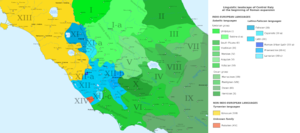Language family
The Latino-Faliscan or Latinian languages form a group of the Italic languages within the Indo-European family. They were spoken by the Latino-Faliscan people of Italy who lived there from the early 1st millennium BCE.
Latin and Faliscan belong to the group, as well as two others often considered dialects of archaic Latin:[citation needed] Lanuvian and Praenestine.
As the power of Ancient Rome grew, Latin absorbed elements of the other languages and replaced Faliscan. The other variants went extinct as Latin became dominant. Latin in turn developed via Vulgar Latin into the Romance languages, now spoken by more than 800 million people, largely as a result of the influence of the Roman initially, and in later times the Spanish, French and Portuguese Empires.
Linguistic description
Latin and Faliscan have several features in common with other Italic languages:
- The late Indo-European diphthong /*eu/ have evolved into ou.
- The late Indo-European /*ə/ from vocalic laryngeals have evolved into a.
- The Indo-European syllabic liquids /*l̥, *r̥/ have developed an epenthetic vowel o, giving Italic ol, or.
- The Indo-European syllabic nasals /*m̥, *n̥/ have developed an epenthetic vowel e, giving Italic em, en.
- They fricativised word-initial aspirated stops from Indo-European: /*bʰ, *dʰ, *gʰ, gʷʰ / > f, f, h, f.
- They assimilated the sequence /*p...kʷ/ into kʷ...kʷ (Proto-Indo-European *penkʷe 'five' > Latin quinque).
Latin and Faliscan also have characteristics not shared by other branches of Italic. They retain the Indo-European labiovelars /*kʷ, *gʷ/ as qu-, gu- (later becoming velar and semivocal), whereas in Osco-Umbrian they become labial p, b. Latin and Faliscan use the ablative suffix -d, seen in med ("me", ablative), which is absent in Osco-Umbrian. In addition, Latin displays evolution of ou into ū, though this happens later than the Latino-Faliscan era, occurring around the 2nd century BCE (Latin lūna < Proto-Italic *louksnā < PIE *lówksneh₂ "moon").
Phonology
It is likely that the consonant inventory of Proto-Latino-Faliscan was basically identical to that of archaic Latin. Consonants not found in the Praeneste fibula are marked with an asterisk.
The /kʷ/ sound still existed in archaic Latin when the Latin alphabet was developed, since it gives rise to the minimum pair: quī /kʷiː/ ("who", nominative) > cuī /ku.iː/ ("to whom", dative). In other positions there is no distinction between diphthongs and hiatuses: for example, persuādere ("to persuade") is a diphthong but sua ("his"/"her") is a hiatus. For reasons of symmetry, it is quite possible that many sequences of gu in archaic Latin in fact represent a voiced labiovelar /gʷ/.[citation needed]
